DPHS and Capo Cares seek historic plaques to honor two historic Doheny-era parks
By Toni Nelson, guest author

Visitors to Capistrano Beach seldom fail to take in the breathtaking coastal vistas from two of the area’s most beautiful landmarks — Pines Park and Palisades Gazebo Park. They may not be aware that they are
also treasured historic sites, testaments to the contributions of the iconic Doheny family who were responsible for the development of this scenic coastal community almost a century ago.
The Capistrano Beach Company was established in 1926 by Edward “Ned” L. Doheny Jr. along with Clark and Warren Smith, the twin brothers of his wife, Lucy. They purchased 1,000 acres of palisades and beach to the west of Ole Hanson’s “Spanish Village by the Sea” (now San Clemente) and commenced construction of a coastal development graced by 28 red-tile roofed Spanish colonial homes, 21 of which survive today, prized locally as “Doheny Houses.”
Despite Ned Doheny’s tragic death in 1929, Edward L. Doheny Sr. and his wife Estelle continued the development for many years, but by 1946 almost all of the Capistrano Beach properties owned by the family had been sold. In 1931, following Ned’s death, the Doheny family gifted 41 acres to the State of California in memory of their son, where the family name lives on at Doheny State Beach, visible from both landmark parks. While the development was briefly renamed “Doheny Park” in 1931, the name chosen by Ned, Capistrano Beach, was restored in 1948.
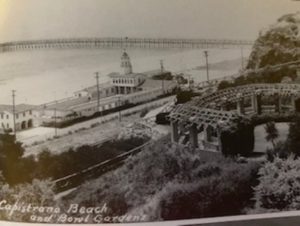
Pines Park was planned and constructed as a community park for the use and leisure of palisades residents. The developers partially filled a craggy coastal canyon to the west of Doheny House #1, which still stands, lovingly restored, at the intersection of Camino de Estrella (named for Estelle Doheny) and Camino Capistrano. The park, once known as “Pines Bluff Park,” or “Doheny Pines Park,” was located directly above the focal point of the 1920’s Doheny development: the stately Capistrano Beach Club, which was lost to history in the 1970s. Recent erosion has unearthed remnants of the old club. Concrete chunks of the original pool and deck, plus fragments of roofing tiles have surfaced from the sand at the now county-owned Capistrano Beach Park, just west of four remaining Doheny Houses on Beach Road.
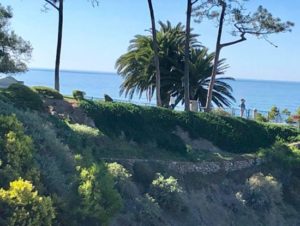
The stone viewing outlook at Pines Park, along with a portion of the retaining walls supporting an original serpentine trail, are still visible today along the eastern bluff of the lower “bowl” area of the park, once known as “Bowl Gardens.” An original elevated viewing gazebo surrounded by white roses, a wooden walking path, staircase and other attractive landscaping sadly succumbed to decades of wood rot and neglect, and was razed by Orange County in the 1960s. Today, the formerly lovely Bowl Gardens consists of a flat, barren, undeveloped plot with an enviable panoramic view. The area is fenced off for safety reasons, but is often infiltrated by squirrels and rabbits, and sometimes local kids who breach the fence to ride bikes or race remote-controlled cars across the dirt lot. In 2017, The Architectural Guild of South Orange County kindly donated an intriguing conceptual design to community group Capo Cares. It featured a bridge across the ravine, viewing decks and a restored walking path. Advocates still hope to see this valuable unused property redeveloped one day, restored to the intended public use envisioned by the Doheny family in the 1920s. The remaining areas of Pines Park — the central viewing area above the bowl and the lower children’s playground, have changed significantly over the decades, benefiting first from the watchful stewardship of local residents and the Capistrano Bay Parks and Recreation District and, after 1989, by the City of Dana Point. In 1991, the city added modern playground equipment and later provided many landscaping improvements and some public art.
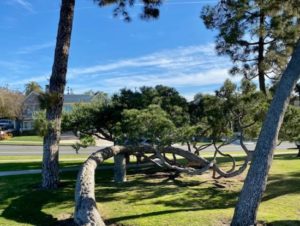
The iconic “climbing tree,” which bends and twists its way along the eastern lawn, was saved by long-term resident Hank Thomas in the early 1970s when he noticed the roots emerging from the ground as the tree leaned precariously. Placing a concrete slab and a wooden post under the offending branch allowed the old tree to ramble and grow, creating a delightful climbing enticement to small children.
A fourth segment of Pines Park today consists of two viewing benches on a narrow ledge above a steep canyon parcel at the eastern end of the park. Transferred to the Capistrano Bay Parks and Recreation District in 1978, and sold multiple times, the property was almost lost to a massive residential structure, until local residents appealed a city Planning Commission decision, demanding the protection of the scenic views promised to the community by the original Doheny developers. The city purchased the property from the developer for $2.1 million in 2004, returning the parcel to the community as part of its beloved Pines Park.
Today, the park is a favorite spot for strolling, dog walking, picnicking, tree climbing and squirrel chasing, plus impromptu yoga and tai chi, and many private and public events. The magnificent pines, many of them decades old, bear witness to the park’s unique setting and its importance to the community’s past, present and future.
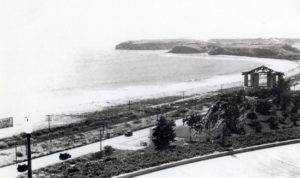
Palisades Gazebo Park is located above Pacific Coast Highway at the first crest of Palisades Drive, a steep road created by the Capistrano Beach Company in 1928 to provide access to the palisades development. This popular landmark consists of two lots on a natural landing along the bluff, a short walk from Pines Park. It overlooks Doheny and Capistrano beaches with panoramic views extending north to the Dana Point headlands, harbor and Catalina Island and south to the San Clemente pier.
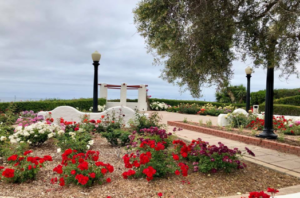
The original gazebo (restored and dedicated by the Capistrano Bay Parks and Recreation District in 1978), three original lamp posts (still in working condition) and several vintage concrete benches still exist on the site. At one time, identical lamp posts lined the seaward side of Palisades Drive, but have since been lost to history. One remaining lamp stands outside Doheny House #1 on Camino Capistrano, and several more dot the median along the Estrella Mall, silent sentinels to the area’s rich past. Beautiful rose gardens were added in the late 1970s by designer James T. Jesser, who oversaw the renovation. According to an article in the May 1978 issue of Sunset magazine, he took special care to choose rose species that would have graced the gardens during the Doheny era. Today, the newly formed community group, the Gazebo Gardeners, provides regular pruning and rose care. This small but beautiful ocean view park is popular as a daily viewing spot for local residents and visitors; a small but charming wedding venue, and often, a welcome respite for those who walk up from the beach to their homes in the palisades.
Both Pines and Palisades Gazebo Parks truly have a significant place in the rich and interesting history of Capistrano Beach. Both stand as testaments to the dreams of the son of an oil tycoon and the entire Doheny family — a family that left a lasting imprint on Southern California, generously gifting not only Doheny State Park, but two priceless public spaces with panoramic views that will be enjoyed by the community and its visitors, hopefully for centuries to come.
Community advocacy group Capo Cares, with the support of the Dana Point Historical Society, is currently seeking the placement of plaques to recognize the historic significance of Pines Park and Palisades Gazebo Park for the people of Capistrano Beach, the larger community of Dana Point and the County of Orange.
